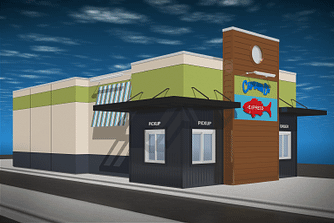CEO says the chain is set up for double-digit growth in comps and EBITDA this year.
Captain D’s expects to open 15 stores this year.
QSR | Ben Coley | March 3rd, 2021
CEO Philip Greifeld says the chain, which has more than 540 stores, ended 2020 with record sales growth, and has begun this year with double-digit increases in same-store sales and EBITDA. Captain D’s didn’t lose any market share as its 30 percent dine-in business transformed into 100 percent carryout, drive-thru, and delivery, with online sales doubling year-over-year. The brand handled the extra volume through its drive-thru by reducing wait times roughly 45 seconds.
Greifeld is a believer in “quality begets more quality.” So when operations and guest service improve, so do top-line sales and unit expansion.
“I think what we have successfully done is we have captured a unique market niche in the [quick-service restaurant] space,” Greifeld says. “Over the years, we’ve successfully democratized seafood. We’ve become a destination for quality seafood at everyday affordable prices. Simply put, there’s no one in America doing quite what we are doing.”
On top of those figures, the chain pushed the boundaries of its geographic territory. In 2020, Captain D’s opened in Michigan, its 23rd state. Greifeld says the nearest unit is probably 150 miles away, but the location is garnering 20 percent higher sales than the system average. It was one of 10 stores that opened across the Southeast and Midwest last year. To set itself up for the future, the brand also signed five franchise development agreements to bring 17 restaurants to markets like Dallas-Fort Worth and Atlanta.
In 2021, franchisees will develop around the greater Chicago area for the first time. In addition, the chain will enter Utah via a quick-service operator who wants to cross-pollinate with another franchise. These stores will be among 15 scheduled to open this year. Greifeld foresees Captain D’s approaching a double-digit rise in comps in 2021, as well as another record increase in EBITDA.
“What we certainly have found out, even pre-pandemic, is that our brand is very geographically portable,” Greifeld says. “There is a need for Captain D’s in the marketplace. It’s an underserved, under-penetrated category, and we’re clearly the leader in the [quick-service restaurant] seafood space.”
The new year also marked the introduction of Captain D’s Express model—a drive-thru only prototype designed to fit on .35-.5 acres of real estate in metro and highly populated markets. The store has an average footprint of 960 square feet and includes a walk-up window for ordering and pickup.
Though the model fits exactly with today’s pandemic-related trends, the idea was kick started before the COVID outbreak. The Captain D’s leadership team saw its mix shifting from dine-in toward the drive-thru channel. And with real estate and construction expenses escalating, it seemed like the ideal time to develop a smaller, more efficient model with lower costs of entry for operators.

The new prototype was revealed in November after almost two years of development. The first Captain D’s Express will be operated by existing multi-unit franchisee, Anil Dossani. The store is expected to open Q2 in Atlanta. The franchisee will follow that with two more Express models in the same market in the coming years.
“It substantially affords us the opportunity to situate ourselves on a smaller piece of real estate, reduce our construction costs, substantially reduce the labor that is required, and substantially reduce the food costs with a limited menu,” Greifeld says.
“This economic model will produce some industry-leading cash-on-cash returns,” he continues. “We have our first one that will open up in Georgia in a matter of two months. I think from there, when existing and new franchisees see the returns from this concept, it’s going to be a big growth driver for Captain D’s.”
The Express unit expands upon Captain D’s flexible selection of store designs. The chain has options for 62-, 44-, and 22-seated locations based on demographics and demand in the market. The chain is also poised to capitalize on conversion opportunities as closures continue to pile up nationwide.
Greifeld explains these multiple offers are available because Captain D’s knows it can operate profitably in different types of towns, from rural America to dense, inner city markets. Additionally, history shows wide acceptance of the brand from a variety of income levels, ethnicities, and backgrounds.
“So armed with that, it affords us the opportunity to go to many different types of towns where maybe you don’t need a lot of seating or maybe only need 22 seats or 44 seats and that 60 seats or 80 seats, or maybe only need a drive thru-only channel,” Greifeld says. “So based on who we are as a company, who we are as a brand, and the needs of our guests, we offer franchisees a variety of different development opportunities, and it’s received very, very well. On a prospective basis, we certainly see ourselves building more 22 seaters or 40-seat restaurants.”
As franchises expand, so will the company portfolio, Greifeld says. Currently, Captain D’s is about 55 percent company-owned and 45 percent franchised. The CEO estimates that this year’s openings are about 90 percent franchise and 10 percent corporate.
Greifeld says there’s nothing wrong with the asset-light model, and that he could’ve done it in the past. He even indicated it may be deployed in the future. But he hasn’t chosen that path yet because of his belief in the operations team. The CEO also notes the method completely aligns the company with franchisees in terms of restaurant profitability.
“So if we are going to do investment spending of a dollar, that dollar is going to be spent at a company restaurant and franchise restaurant, as well,” Greifeld says. “… I think our franchisees greatly appreciate that. It makes us operate our business being highly, highly sensitive to not just sales and sales volume, but also the profitability for the restaurant based on those sales volumes. It serves our franchisees very well. Franchisees that have joined us from other franchise systems are highly appreciative of that.”
Greifeld isn’t certain as to whether the chain will venture into trends such as ghost kitchens or virtual brands. However, the Captain D’s leader is confident about the brand being poised to take advantage of a post-COVID landscape that will see fewer restaurants and consumers moving away from delivery and grocery consumption.
If the whole world was vaccinated tomorrow and everyone returned to their pre-pandemic dining habits, Greifeld feels Captain D’s would be well-positioned to maintain and grow its market share.
“I think there’s more opportunities out there to capture more guests that maybe stayed at home as well as new trial that we garnered during this pandemic,” Greifeld says.

